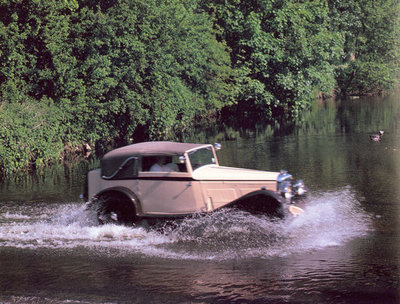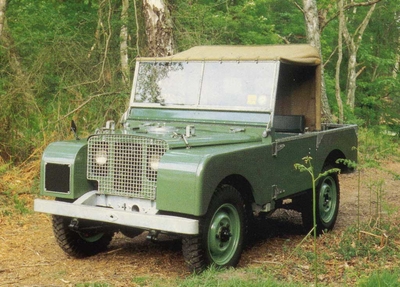Simultaneously with the end of the motorcycle production the Rover 9 with a watercooled four cylinder enigne was presented to the public. The 1.074 ccm engine with 20 PS was build until 1933.
Spencer Wilks, who joined 1929 the company, turned around the history of the company. He an his brother Maurice pointed the way for the company from 1932 on.
In 1933 the Meteor- and Pilot-Modells were completely redesigned. As a special feature the Lucas-Startix-System was introduced. The idea was to start the engine on stall automatically.
From 1933 till 1939 the market share rose continously from 2,2% to 3,2%. The first dividends after 13 years where payed in 1936 to the shareholders. The profit margin for the modells P1 and P2 where less than 5%.
The Rover modells P2 and P3
With the standardisation of the engine design, e.g. five different cylinder bores for the 4 and 6 cylinder engines, all models from the HP10 up to the HP20 had been covered. All had the same coasting, gearbox and axles at three different wheel bases.
The Rover 12, which was presented 1937, was atypical example for Rover’s self image: big, heavy and with moderate performance figures, therefore of high quality equipment and thoroughly processed.
The running of the 4 cylinder engine was as smooth as the 6 cylinder and detailed work was remarkable. For instance the gearstick, it was fixed that way to the chassis, that the vibration wasn’t transferred to the interior.
The 14th of November 1940 brought heavy air raids to Coventry by the German Luftwaffe, causing severe damages to the British Motor Industry, by which not only Triumph was grounded, also several Rover “Shadow Factories” which had been built as the war began, suffered great damages as they produced aircraft engines and the legendary Gas Turbine
The Rover Scarab - the minicar
1931 at the London Motor Show, a small, comic little vehicle was presented as the Rover Scarab, which should occupy the market for Rover, with a motorcycle engine at the rear it was up to date then, but fortunately time past by very quickly, the Scarab never went into production, only some photos and leaflets have survived.
Rover began to develop and build big, solid Vehicles, fortunately.
An article about the Scarab was published in the VikingNews.
The Reconstruction
After the War, the Coventry Factory was sold and the production moved Solihull. Now the HP10 and HP20 could go into production, also an Open Tourer.
In February 1948 the P3 and P2 followed, most panels from pressed steel remained unmodified. The chassis was new, also the front McPherson independent suspension, four and six cylinder engines. But the price of 10106 pounds slowed the selling of the 75 (predecessor of the modern 75), which was launched one year later. The end for the P3 came October 1949.
The Rover Cars of the P2 and P3 series were vehicles, just as we understand them as typical British today, fine, tough with much leather and wood just “one of Britain’s fine cars”, as a promised in adverts those days.
1948 a one more legendary automobile was presented: The Landrover!












